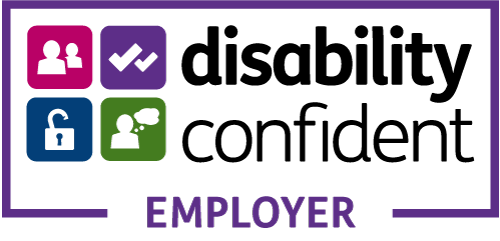
A creative resource designed for people living with brain injury, in collaboration with Studio Wayne McGregor.
Content
- How to Use this Resource
- Benefits of Dance and Movement
- Useful Tips for Delivering a Session
- Beginning a Session
- Posture Awareness
- Warm-up Exercises
- Contact and Group Skills
- Creative Tasks
- Sharing of any Work Created
- Ending a Session
- Music
- Equipment
- Example Sessions Plans
- About
- Credits
How to Use this Resource
This resource is intended to support staff and anyone who is interested in leading or taking part in a movement session for those living with a brain injury or similar disability. It will provide you with the initial skills to run one-to-one or group movement sessions, as well as helping you to build your confidence in generating new ideas of your own to suit your group.
This resource brings together exercises and creative tasks that have been experimented with over 6 sessions. A small pilot study was also conducted during this time, providing outcomes and feedback from members of their experiences during the sessions.
Benefits of Dance and Movement
Dance is a body-based activity that, like exercise, results in the natural production of endorphins, an established mood booster. Dance incorporates music and rhythm, while allowing participants to utilise their creativity. It also helps to improve physical skills such as mobility, balance, flexibility and co-ordination.
It has been seen to have a positive effect on increasing confidence, ability to work as a group and build a sense of belonging and community.

Useful Tips for Delivering a Session
Space and structure
- Ensure you have a large enough space for a group, clear of obstacles and furniture.
- The optimum length of a session is 60-90 mins depending on the stamina and needs of the participants.
- Repetition and consistency are necessary for establishing a safe creative space.
- A clear beginning and end to your session establishes familiarity and safety. For example, you could begin and end your session in a circle.
- A circle can be returned to throughout the session as a way of focusing the group, giving further instructions and for integration.
- Ensure one leader directs a whole activity as this helps with consistency. The leader needs to explain the activity to the group to ensure a clear structure.
- Try to use as accessible language as possible. E.g. if you have a mixture of people sitting and standing, refer to having weight balanced through both sides of the body rather than through the feet.
Flexibility
- Time needed for each activity will be different for each group. Move on if the group becomes stuck or looking for more variation. Dynamics will change, so what does not work one week may work another time.
- Sessions can build up in length and difficulty over time.
- Do not be afraid to try something new. If a new idea emerges with the group – go for it!
- Give people opportunities to participate in activities either seated or standing depending on safety.
- When introducing contact skills or touch, make sure that the group is comfortable with this and build skills gradually.
Beginning a Session
Chose a way to start your session and repeat this every time. The introduction exercises are to help focus the group, encourage group interaction, and give everyone a chance to say hello.
Intro exercises:
- Pass the pulse: pass the pulse around the circle using palm to palm.
- Pass the beanbag: pass a beanbag around the circle, saying your name as you take it. See how fast you can pass the beanbag around the circle.
Development:
- Tracing the space: before passing the beanbag, take it on a ‘journey’, exploring different movements that move over, under or around different body parts or the space around you. Make eye contact with the next person to ensure they are ready to receive the beanbag.
- As you say your name: state one thing you have done that morning e.g. had a cup of tea. Use the beanbag to trace the movement of that action. This can be done without a beanbag. Encourage the group to copy each other’s movements.
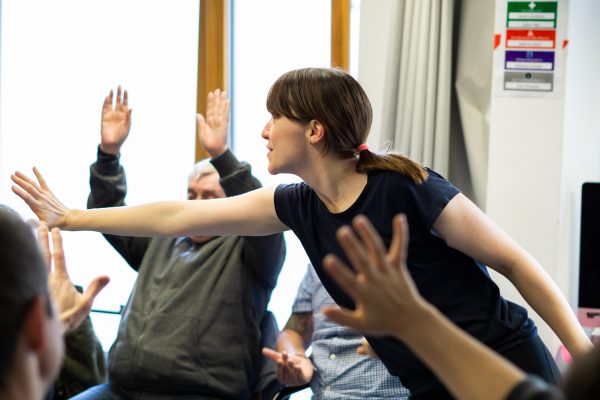
- Passing touch: place a hand on a part of your neighbour’s body e.g. shoulder, knee, to initiate a movement in that part of the body. These body movements could later be used in creative tasks.
- Letter game: say your name and spell the first letter of your name with a body part. E.g. L with elbow, O with top of head. The group repeats back the name and movement.
Development:
- Encourage the group to remember each other’s movements so that you can build it into a sequence.
- Ask group to explore the size, speed or dynamic of their movement/use a different body part.
- Coordination game: build on a series of easy repetitive movements for the group to follow. Build in changes to challenge coordination and memory. Eg.: arms reach up, down, forwards, side (repeat until the group is confident with sequence). Say: “Move as I do”.
Development:
- Do the opposite of what I say e.g. arms reach up – move arms down.
Posture Awareness
These exercises encourage participants to focus on their posture and alignment.
- Wake up massage: start by rubbing hands together to generate heat. Continue to work up the arm to shoulder, squeeze shoulder, brush down arm. Repeat on other side if possible or continue on same side. Tap raindrops on head, down to collar bone. Rub stomach and back. Tap tops of legs. Reach down as far as possible and brush up the body – shake arms out into middle of circle.
- Breathing and posture: hands to chest. Breathing – noticing rise and fall of chest with inhale/exhale. Use arms to stretch up as you inhale and relax down as exhale. Make eye contact across the circle as you follow their stretch.
Warm-up Exercises

Upper body:
Build a sequence that can be repeated incorporating some of the movement you see in the videos below.
Tip: Play with different rhythms and dynamics within the warn-up. The sequence can be repeated each week until the group is confident.
Upper and Lower body:
Rhythm
Encourage group to follow a steady rhythm. Choose music with a steady beat and easy to follow. Use repetitive movements e.g.:
- Tapping thighs/shoulders/top of head
- Stamping feet
- Tapping heels
- Clapping hands
Development: Play with number of repetitions.
Ask group to contribute own ideas and lead group through chosen movement.
Contact and Group Skills
In pairs:
- Follow the leader: mirroring movements. One leads and the other follows, then swap.
- Negative space: create a shape with your body / body part. The other person traces the space around that shape – finding the negative spaces.
- Weight bearing: in a circle, create a statue that connects to the next person in some way. Can be a mixture of sitting and standing.
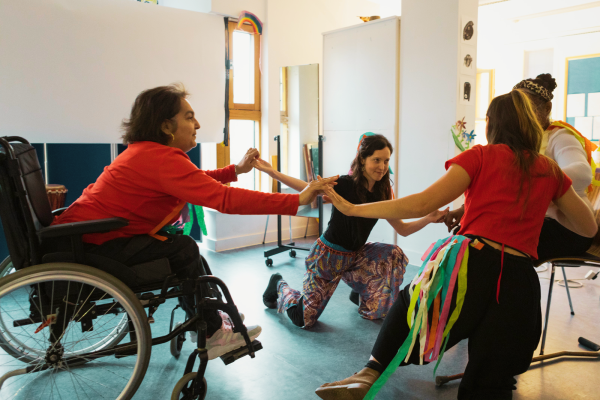
Creative Tasks
- Tracing body parts: in pairs, offer a body part to your partner. They choose to move or trace over/ under or around the body.
Choose 4 and add together to make a duet.
Play with dynamic of each movement e.g. one sharp/slow as if moving through water etc.
- Action words (as shown in video below): teach sequence of six moves based on words e.g.: Swipe – Reach – Ripple – Break – Push
Learn movements as a group, then change order of words to see if remember movement.
Smaller groups: create own movements for each word. Create a flow from one to the other.
- Identity task: in pairs, create four moves that tell something about you eg:
- Spell first letter of name using a body part
- Appearance move – something you like about yourself e.g. big eyes
- Hobby move – something you like to do
- Personality move – Something about your personality
Development:
- Choose favourite move: as a group put the moves together to create a sequence.
Sharing of any Work Created
Following the contact or creative tasks, come back as a group for sharing.
Each pair / small group can demonstrate to the rest of the group – encourage positive feedback.
Ending a Session
- Repeat self massage. Take 3 deep breaths together.
- Stretch using a band (see image below):
stretching upwards, downwards, backwards, forwards, twisting the spine right and left.
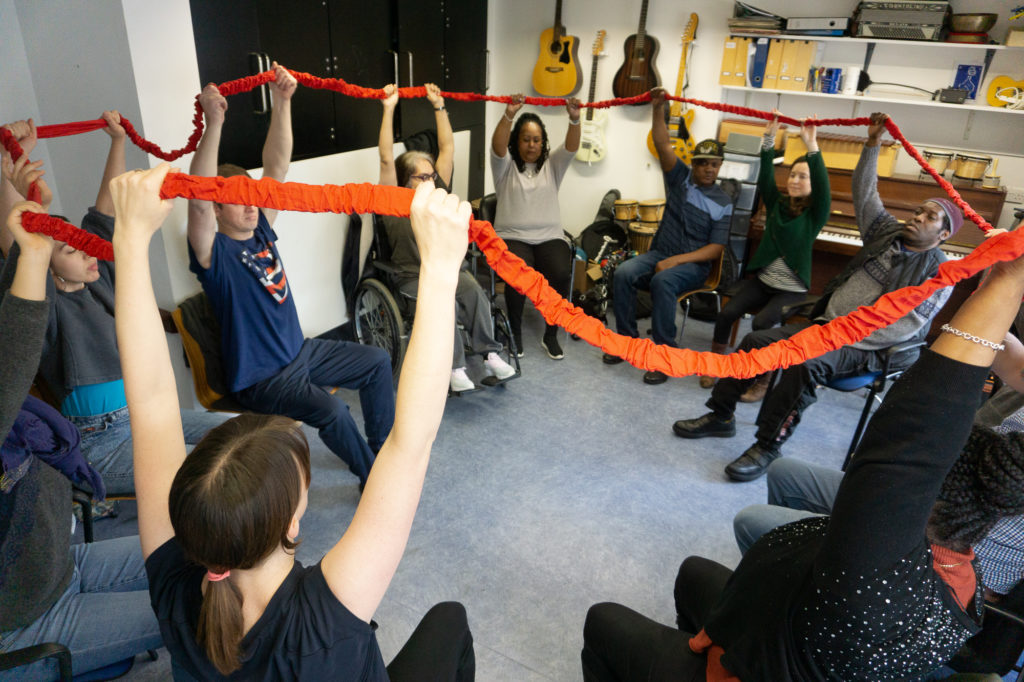
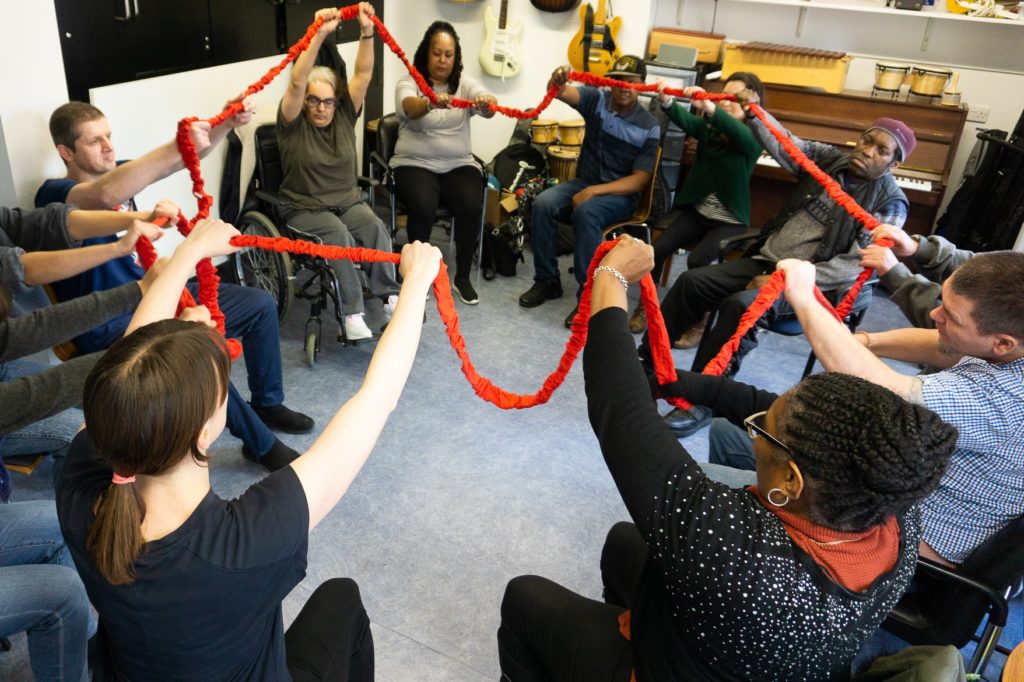
Music
Lyrics / Instrumentals
Here are some examples of music to use, available on Spotify.
Equipment
Example Sessions
These example session plans are based on a 60min session.
- Pass the bean bag saying name. Develop to tracing the space before passing on.
- Wake up massage
- Posture and breath
- Pass the pulse
- Upper body warm up exercise
- Treading
- Trace body part – in pairs leading to duet
- Closing stretch with band
- Name and letter
- Wake up massage
- Posture and breath
- Upper body warm up exercise
- Lowe body rhythm exercise
- Sequence of 6 movements
- Group – developing own movements
- Closing stretch with band / cool down
- Name and movement describing something done that day
- Wake up massage
- Posture and breath
- Upper body warm up exercise
- Lowe body rhythm exercise
- Identity creative task in pairs
- Sharing of work created
About
Studio Wayne McGregor is a creative engine for choreographer and director Wayne McGregor CBE, and the home of his lifelong enquiry into thinking through and with the body. It is a nexus of partners who explore movement, artistry, thought and collaboration. With Wayne McGregor as its center, this collaborative network encompasses dancers, writers, composers, producers, visual artists and more. The studio’s highly specialised learning and research programs explore the individual creative potential in over 10,000 participants each year.
Headway East London is a charity supporting people affected by brain injury. It provides therapies, advocacy, family support and community support, alongside a day service. It is a place where members can make the most of their interests and abilities. Headway offers specialist support and services for over 200 survivors in the local area each week.
Credits
Jasmine Wilson – Director of Engagement at Studio Wayne McGregor.
Fiona Allan – Physiotherapist Headway East London – fiona.allan@headwayeastlondon.org
Stephanie Kelley – Therapy Technical Instructor Headway East London – stephanie.kelley@headwayeastlondon.org
Special thanks to Tirzah, Theresa, Ken, Evaldas and Trevor, members of Headway East London.
Videos filmed and edited by Ed Prosser.

